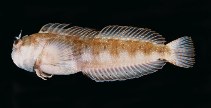| Family: |
Blenniidae (Combtooth blennies), subfamily: Salariinae |
| Max. size: |
5 cm TL (male/unsexed) |
| Environment: |
reef-associated; marine; depth range 2 - 10 m |
| Distribution: |
Eastern Indian Ocean and Western Pacific: Sri Lanka and Christmas Island in the Indian Ocean, southern Japan and Hong Kong. |
| Diagnosis: |
Dorsal spines (total): 13-13; Dorsal soft rays (total): 18-19; Anal spines: 2-2; Anal soft rays: 21-22. Closely related to Rhabdoblennius, but differs by 13 dorsal spines. Nasal and nuchal cirri palmate. Supraorbital with 2 long, slender cirri. |
| Biology: |
A rare species (Ref. 559). Adults live in abandoned worm tubes, solitary or in loose groups (Ref. 90102). Oviparous. Eggs are demersal and adhesive (Ref. 205), and are attached to the substrate via a filamentous, adhesive pad or pedestal (Ref. 94114). Larvae are planktonic, often found in shallow, coastal waters (Ref. 94114). |
| IUCN Red List Status: |
Least Concern (LC); Date assessed: 27 March 2009 Ref. (130435)
|
| Threat to humans: |
harmless |
Source and more info: www.fishbase.org. For personal, classroom, and other internal use only. Not for publication.
